Everything You Need To Know about Excavators
Excavators are an essential piece of heavy equipment for most construction projects. Often referred to as diggers, excavators are used for all kinds of jobs like material handling, landscaping, demolition, mining projects, river dredging and construction.
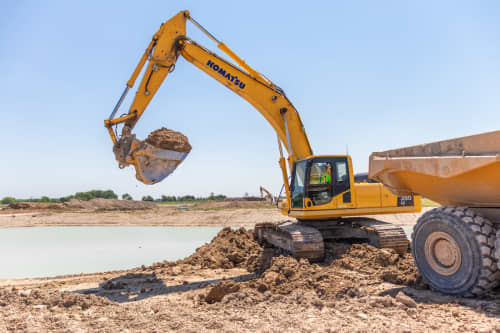
The Makeup Of An Excavator
The anatomy of an excavator is made up of a boom, dipper (or stick) and bucket. These pieces connect to a cab that sits on a rotating house. Most houses can rotate a full 360 degrees. Excavators are available with either tracks or wheels depending on the manufacturer and what the nature of a project is.
Excavators are available in a variety of sizes and can weigh up to 180,000 lbs. There are many other attachments for excavators that can take the place of the digging bucket to diversify the machine. By swapping out the bucket for an auger, drill, ripper or rake the excavator can be used for many different jobs.

Choosing the Right Excavator for The Job
Thebest way to choose what excavator rental is needed for your project is to assess what exactly you need the machine to do. Identifying the right size of excavator, what attachments are needed and how long you need the rental for will help you determine the best machine for your job. It is more efficient for a job to rent the right size equipment for what is needed instead of trying to make one piece fit for a variety of jobs.
What Are The Different Types of Excavators?
An excavator is often used for earthmoving projects. That being said, the variety of popular excavator rental sizes and attachments available for this machine make it useful in excavation projects of all sizes. From a landscape project to the construction of a completely new high-rise skyscraper, you can expect to see an excavator on almost any construction project.The variation in size allows them to be used in big construction projects and small backyard renovations. Wheeled excavators are popular in Europe and are used for working in urban areas since their wheels are kinder to finished roads and pavement than the traditional metal track.

The Cable vs. Hydraulic Excavator
The difference in the cable and hydraulic excavator comes from how the parts of the machine move. Cable excavators which use a series of steel wires and cables to move the main parts replaced the steam shovels in the early 1900s.
Hydraulic excavators work by allowing the driver to use levers to control the movement of the hydraulic fluid to push and move the cylinders that control the boom and bucket of an excavator.
The 7 Kinds of Excavators
There are six key types of excavators available on the market: Crawler, Dragline, Suction, Skid Steer, Long Reach, Mini Excavator and Wheeled Excavator.
1. Crawler Excavators:
The most commonly recognized excavator used for mining, trench digging and landscape grading the crawler excavator is what most people picture when they hear the word “excavator”. This kind of excavator is available on wheels instead of a track.
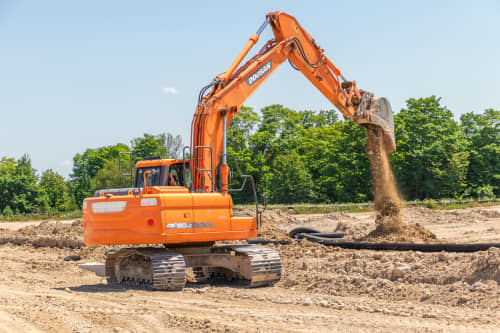
2. Dragline Excavators:
A larger kind of excavator that uses a hoist rope and dragline system to clear earth for underwater projects, pile driving or road excavations.
3. Suction Excavators:
Uses water jets and a high-pressure vacuum to clear dirt, soil, and debris. Operated out of a wheeled vehicle the suction excavator is used for underground applications, debris cleanup and other delicate excavation projects.
4. Long Reach Excavators:
With arms that extend up to 100 feet with attachments, the excavator is good for heavy-duty digging and industrial demo projects.
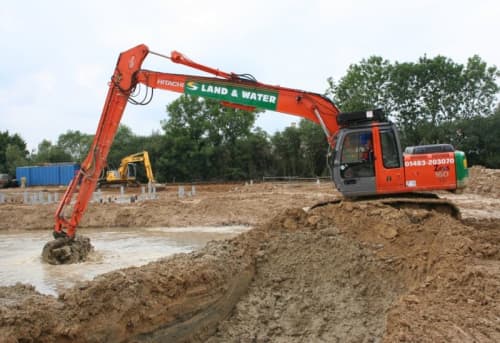
5. Mini Excavator:
A compact, smaller version of a crawler excavator, mini excavators – often referred to as mini diggers – are useful in narrow job sites, job sites with obstacles, and jobs with delicate terrain like landscaping. Mini excavators have zero tail-wing capability and are ideal for small jobs.
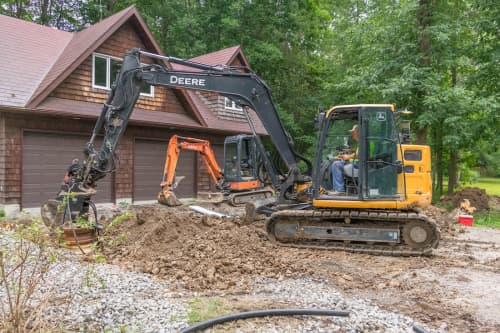
6. Wheeled Excavator:
The wheeled excavator is the same as a regular excavator but is fitted on wheels instead of tracks. Growing in recognition for their use in city projects, wheeled excavators are becoming more and more popular.

Attachments for Excavators
There are many different mini excavator attachments out there. Renting a specialized attachment can make your machine function more efficiently and work smoother for specific jobs. While there are 10 more popular types of excavator attachments - both for mini excavators and standard machines - you can pretty much rent the attachment that works best for you.
The traditional excavator is fitted with a bucket that digs towards the cab and machine. This digging bucket can be fitted with a thumb that makes it easier to lift and move materials. There are other types of buckets that can be attached to an excavator.
A rock bucket and V bucket are two example bucket types that can be attached to an excavator. A rock bucket looks similar to a digging bucket but with longer sharper teeth and a narrow V-shaped edge for cutting. The reinforced structural parts of a rock bucket give it the ability to break through hard rock while still maintaining structural integrity. The V bucket simplifies the task of digging trenches and is useful for laying utility cables and pipes.
Excavators can also be fitted with an auger attachment for digging holes, hammers for breaking up hard concrete and rock, rippers, compactors, rakes, and many other different kinds of tools. All of these attachments help to make the excavator a true multipurpose equipment type.
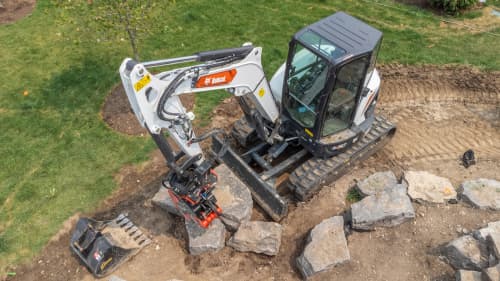
Manufacturers of Excavators
There are many different manufacturers to consider when looking to rent or buy an excavator. Most companies make different sizes and models of excavators to accommodate projects of all sizes and natures.
A variety of excavators are available for rent through DOZR. There are options to search for excavators ranging from 18 ton to 80 ton as well as high and long reach excavators or wheeled excavators. The following is a look at some more popular brands of excavator manufacturers.
Caterpillar
Caterpillar – also called CAT – was founded in 1925 when C. L. Best Tractor Company joined with Holt Manufacturing Company – the same Holt family responsible for the continual-track system.
Caterpillar is one of the most recognized brands of heavy equipment and machinery and is one of the largest heavy equipment manufacturing companies in the world.
Caterpillar introduced a series of excavators – called the 200 series – in 1972. Now its excavators feature fuel-efficient engines, latest safety tech and are designed with productivity in mind. Caterpillar manufactures many kinds of excavators.
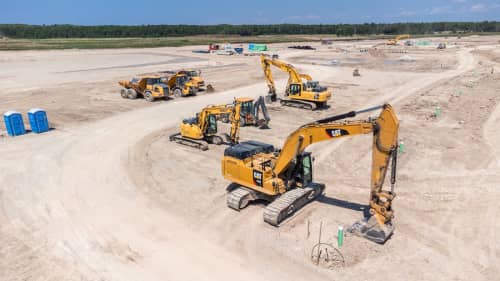
Volvo
It was 1832 in Eskilstuna, Sweden when 27-year-old Johan Theofron Munktell prepared the foundations for the company Volvo Construction Equipment.
The city of Eskilstuna commissioned Johan to build an engineering workshop to help grow the local mechanical industry. In 1853 Johan created Sweden’s first locomotive.
At the same time, two brothers named Jean Bolinder and Carl Gherard returned to Sweden from England after studying engineering technology to start their own business.
100 years later the engineering workshop created by Johan merged with the company created by the Swedish brothers to form AB Bolinder-Munktell. It was this company that was purchased by Volvo in 1950.
Today Volvo continues to push the boundaries of construction equipment manufacturing. In 2019 Volvo CE announced the goal of launching a range of electric compact excavators and wheel loaders by mid-2020.
Crawler excavators, wheeled excavators, mini excavators and short swing excavators are all offered by Volvo. Volvo is most well known for its wheeled excavators. With the same options for attachments and stability level as a tracked excavator, they offer compact and medium-wheeled excavators.
Komatsu

Komatsu was established in 1917 in Japan and established in North America later on in 1970. Their introduction to the American market for hydraulic excavators happened with their H-Series in the 1960s, a little before they truly established themselves in America.
The modern excavators from Komatsu feature new engines and hydraulic technology which drives fuel efficiency. The company works to build their excavators with the best quality materials and superior craftsmanship.
From small and compact to mining excavators, Komatsu offers a variety of excavators for all kinds of projects. Mid-range models like the Komatsu PC170LC-11 boast a 121 hp with 2,100 rpm with an operating weight of up to 43,115 lbs. Komatsu also manufactures the PC240LC-10 Super Long Front which provides a productive and stable equipment base for digging deep ditches or sloping applications.
The working range of the super long front is huge. The PC240LC has 177 hp with 2,000 rpm and has an operating weight of up to 58,521 lbs.
John Deere & Co
John Deere established his company – named after himself – in 1837 – after the invention of the polished steel plow. In 1969 the first John Deere excavator, the JD690, was introduced. Now they make over 20 different kinds of excavators ranging in size, weight, and horsepower.
Their largest excavator – the 870G LC Excavator allows for 31ft in digging depth and a 512 hp. Although only specific kinds of the project would need these kinds of abilities, it is still pretty cool. The 75G is a mid-sized excavator that still allows a 15ft digging depth, 56.9hp and weighs just under 18,000 lbs.

Potential Hazards & Safety Protocols for Excavators
Operating any kind of heavy equipment could pose a safety hazard. It is important to always be careful and to only operate a piece of heavy equipment after receiving proper training. Being consistent and following safety protocols can help keep all excavation operations safe. Here are some ways to stay safe while operating an excavator:
- Never dig under structures like sidewalks without proper support systems
- Wear a hardhat, safety vest, ear protection, and respiratory protection
- Never dig underneath an excavator
- Maintain the cab by cleaning up garbage and maintaining clear windows
- Avoid making sharp turns or sudden movements while operating an excavator
- Always lower the bucket when parked and park on a level surface
- Do not travel diagonally on slopes but directly up
- Map out an excavator route that is as flat as possible
- Never exceed the maximum weight capacity of an equipment piece
- Lower the bucket closer to the ground when driving for visibility purposes
- Check all blind spots before moving equipment
- Make sure to report any safety hazards and have any needed repairs performed immediately
- Always wear a seatbelt
- Check site plans and call local utility companies before beginning to dig
The most important point to remember for any operation of heavy equipment is to only do so if training has been provided and it is safe to do so. There are also some tips and tricks online for special projects like operating an excavator on a slope. Always request training before agreeing to operate a piece of new machinery.
The History of the Excavator
The first machine to resemble an excavator was the steam shovel. An ancient dinosaur next to the modern excavator, this piece of equipment was a game-changer when it was invented by William Otis who in 1839 received a patent for the design. It was originally fitted on railway tracks to allow mobility.
The machine could move up to 300 cubic yards a day compared to the 12 cubic yards that could be moved by a man. This machine was used to build the Panama Canal and dig the foundations of early skyscrapers. The machine was used and updated into the 1920s as tracked and wheeled equipment became more popular. In 1931 the last railroad shovel was shipped.

Much like with the bulldozer and other pieces of equipment, there were various pieces that had to come together to create the excavator. Sir W.G. Armstrong & Co. was a British business that had developed the hydraulic system that would be used in the modern excavator.
Designed to use water instead of hydraulic fluid which is used now, this system was invented in 1882, the first hydraulic shovel – more similar to the one used today than the steam shovel – was patented by Kilcore Machine Co in Minnesota in 1897 and used the technology developed by Sir W.G. Armstrong & Co.
None of these excavators could rotate the full 360 degrees that is now associated with the modern excavator. This didn’t happen until the 1960s when a French company called Poclain invented an excavator with cylinders and a hydraulic pump. The TY45 made history as the first fully revolving hydraulic excavator.
The Excavator: FAQ
Can an excavator be used as a crane?
Lifting is not the function of an excavator and can pose a risk to both the equipment, the operator and the surrounding area. Excavators are sometimes used as a crane to lift and move equipment on site. It should be done with great care and caution. Only an operator who is fully trained in using an excavator for lifting should try to lift with the machine.
Can an excavator lift a shipping container?
Excavators are not made to lift. However, they are used to lift and move equipment on site. By renting the right sized equipment for a job, an excavator is can have a variety of capabilities including lifting a shipping container. The important point to note for this is that an understanding of the weight and size of the container would be needed to ensure that the correct excavator is used for the task.
In order to lift a shipping container high enough to load it onto something, the center of gravity and weight of the excavator would have to be enough to handle the load. No piece of earthmoving equipment should lift a load outside of its rated capacity.
How deep can an excavator dig?
The depth capacity of an excavator will depend on the size of the equipment. Some specific kinds of excavators – like a long-reach model – make it easier to dig deeper than possible with a regular excavator.
What is the proper digging position for an excavator?
The proper position for digging with an excavator will differ depending on the terrain, the size of the equipment, the location of the dig site and the nature of the job.
The best way to set up a dig for success is to take the time to plan before starting. Organizing where the scoop pile will go and where to stage other needed materials will keep the dig safe once it is started. Reading site plans to identify underground hazards like wires or pipes will ensure the productivity and efficiency of a job. Take time to paint lines before digging to align the first dig.
All of these steps help to create a safe working environment which is the first step to proper digging with an excavator.
What is the difference between an excavator and a backhoe?
While both a backhoe and an excavator can be used for digging they are two distinct pieces of equipment with different functions. A backhoe is a much smaller piece of equipment that is a standard tractor body with a boom bucket on the back end and a bucket or other attachment on the front. An excavator only has a digging bucket – or other attachment – on the front end.
A backhoe has a rotation radius of 200 degrees while the excavator can rotate a full 360.
Backhoes are very versatile and can be used for digging, loading, lifting, pushing and moving. They are often wheeled pieces of equipment. Excavators are primarily used for digging, lifting large objects, landscaping, and demolition. While wheeled excavators are growing in popularity most excavators are tracked.



Comentarios
Publicar un comentario